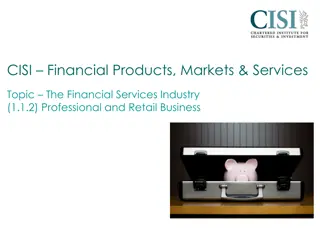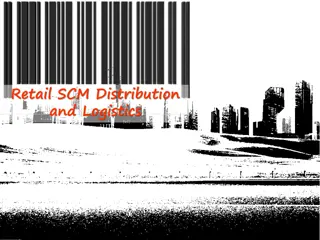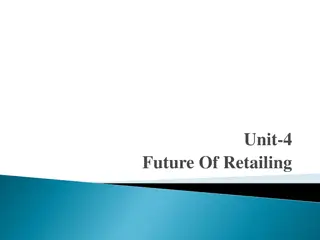Understanding Retail Management: An Overview of the Retail Industry
Retail management encompasses all activities related to selling goods and services to end consumers. It is a competitive industry, offering a wide range of products and services to meet consumer needs. This involves various types of retailers, market segments, and channels. Malls, specialty stores, discount stores, and department stores are some key players in the retail sector, each catering to specific market segments with distinct offerings.
Download Presentation

Please find below an Image/Link to download the presentation.
The content on the website is provided AS IS for your information and personal use only. It may not be sold, licensed, or shared on other websites without obtaining consent from the author. Download presentation by click this link. If you encounter any issues during the download, it is possible that the publisher has removed the file from their server.
E N D
Presentation Transcript
Unit-1 Retail Management
Contents:- 1.Introduction to Retailing Structure of retail industry Types of retailers Market segments and channels Market trends Retail life cycle
Retailing comes at the end of the marketing distributive channel. The word retail has been derived from the French word retaillier and means to cut a piece or to break bulk . It covers all the activities involved in the sale of product and services. Retailing is a high intensity competition industry and second largest globally. The reason for its popularity lies in its ability to provide easier access to a variety of products, freedom of choice, and many services to consumers. The size of an average retail store varies across countries depending largely on the level of a particular country s economic development.
Definition According to Phillip Kotler: "Retailing includes all the activities involved in selling goods or services to the final consumers for personal and non- business use."
Malls: The largest form of organized retailing today. Located mainly in metro cities, in proximity to urban outskirts. Ranges from 60,000 sqft to 7,00,000sqft and above. They lend an ideal shopping experience with an amalgamation of product, service and entertainment, all under a common roof. Examples include Shoppers Stop, Piramyd, Pantaloon. Specialty Stores: Chains such as the Bangalore based Kids Kemp, the Mumbai books retailer Crossword, RPG's Music World and the Times Group's music chain Planet M, are focusing on specific market segments and have established themselves strongly in their sectors.
Discount Stores: As the name suggests, discount stores or factory outlets, offer discounts on the MRP through selling in bulk reaching economies of scale or excess stock left over at the season. The product category can range from a variety of perishable/ non perishable goods . Department Stores: Large stores ranging from 20000- 50000 sq. ft, catering to a variety of consumer needs. Further classified into localized departments such as clothing, toys, home, groceries, etc. Department Stores: Departmental Stores are expected to take over the apparel business from exclusive brand showrooms.
Hyper marts/Supermarkets: Large self service outlets, catering to varied shopper needs are termed as Supermarkets. These are located in or near residential high streets. These stores today contribute to 30% of all food & grocery organized retail sales. Super Markets can further be classified in to mini supermarkets typically 1,000 sqft to 2,000 sqft and large supermarkets ranging from of 3,500 sqft to 5,000 sq ft. having a strong focus on food & grocery and personal sales. Convenience Stores: These are relatively small stores 400-2,000 sq. feet located near residential areas. They stock a limited range of high- turnover convenience products and are usually open for extended periods during the day, seven days a week. Prices are slightly higher due to the convenience premium. MBO s: Multi Brand outlets, also known as Category Killers, offer several brands across a single product category. These usually do well in busy market places and Metros.
Amarket trend is a perceived tendency of financial markets to move in a particular direction over time. These trends are classified as secular for long time frames, primary for medium time frames, and secondary for short time frames. Traders attempt to identify market trends using technical analysis, a framework which characterizes market trends as predictable price tendencies within the market when price reaches support and resistance levels, varying over time.
The retail life cycle theory holds that retail institutions experience the cycle of innovation, growth, maturity and decline, like goods and services that they sell. similar to that of the product life cycle The market traits and strategies which are taken by retail institutions should differ in variable stages of retail life cycle
Stages Of Retail Life Cycle 1. Innovation stage In the innovation stage, in which the reformation and development of business methods promote the emergence of new retail formats, the operating characteristics of new formats have not been understood by both consumers and the industry, lowering market share. Moreover, because of the development cost of new formats, it is hard for retail companies, which apply the new methods, to make profit at this stage. This theory holds that the innovation in retail institutions is realized through the reformation of business methods. The reformation of business methods is mainly realized by decreasing the cost of operation and the price of products or services. However, it may also be innovated through improvement of product mix, customer service, sales, store selection, store design or sales promotion, business hours, logistics system and other ways, some of which are usually combined and innovated. Sometimes the company which leads the new retail format may become the target of hit (Roth, V. J., & Klein, S. 1993). During the period, the emergence of new forms can also lead to the blow of competitors and retaliation. In this stage, it has little impact on the existing competitive structure for its low market share.
2. Growth stage In the growth stage, Langlois, R., & Robertson, P. (1995) points out that the new business formats start to be accepted by consumers and traits of new formats are widely understood in the industry. As a result, the market share begins to ascend and copycats are also on the rise. The competition between companies that apply traditional methods and new methods gets more intense. At that time, companies who have reformed their operating activities firstly can increase the marker sales and the profitability. At the meanwhile, the competition between companies of new and original retail formats begin to turn out white-hot. With the rapid growth of reformed companies, customers of companies without innovation intend to choose products and services of innovative companies. Therefore, the unreformed retail institutions begin to take various actions to reduce the loss of customers. In fact, many companies which use original retail formats meet challenges of new formats with the positive attitude and apply some new methods in the existing formats. The competition of different retail formats is unique and increase the vitality in the market.
3. Maturity stage In this stage, companies of new retail formats are incapable of taking more market share and expand the customers' base. In this period, companies which won out in the growth stage are trying to maintain the market share. However, the profit margin begins to decline because the new retail formats could not make any company have edge on the others and companies have to decrease the price in order to defeat competitors. Therefore, how to decrease the cost is the main problem that each enterprise faces. In order to pursue the differential advantage in the period of competition, the enterprises compete to make the market more mature and stable. Characteristics of new formats have been gradually lost and new formats change to traditional formats. Thus it becomes an important opportunity for the emergency of another new format. For chain businesses, in this stage, they need to consider to close inefficient shops and open new shops in good addresses as well as develop to diversified and compound retail organization (Turner, S. 2002). It should be pointed out that the retail format even in the maturity stage can be improved to make the company come back to the growth stage. According to the research of Sun, L., Kay, R., & Chew, M. (2009), department stores in the United States has been in the maturity stage after World War II. After that, the development of shopping centers gave department stores an opportunity to grow again because department stores were different at that time form before and they were reformed based on the model of shopping centers .
4. Decline stage In decline stage, the new formats have become the traditional ones and with the change of consumers' buying behavior and the appearance of newer formats, the market begins to shrink and traditional formats (original new formats) could not make any profit but may suffer great loss due to the decreasing sales. During this period, some companies decide to leave the market. As a result, the competition among the same retail formats is not serious but the competition of different formats will get increasingly intense. Companies of the traditional format compete through the price, which makes their profit get less and less. Companies of the new format have edge on the others due to their advantages in other aspects like service, product quality and operation style. The situation of decline stage is similar to the innovation stage but in the term of traditional formats.























